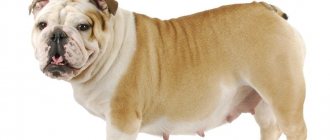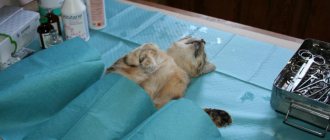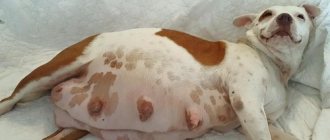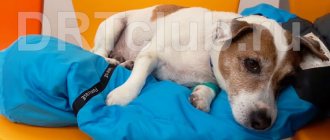Veronica Igorevna Sharipova
veterinarian Petstory
In the modern world, perhaps every pet at least once in its life goes through some procedure or operation that is impossible without anesthesia. Of course, any owner is worried about this event, especially since there is a lot of conflicting information around anesthesia. So what is anesthesia, how to prepare for it and how dogs tolerate it - we will look further in our article.
- Inhalation
- The first day after anesthesia
When is anesthesia used for dogs?
Anesthesia is an artificially induced, reversible condition characterized by the following symptoms:
- loss of consciousness, artificial sleep, amnesia occurs;
- the muscles relax, natural reflexes are completely or partially switched off, the dog is immobilized;
- The nerve endings do not perceive pain, and complete pain relief occurs in the animal’s body.
At the veterinarian's appointment
Indications for the use of general anesthesia for dogs:
- Carrying out abdominal operations.
- Operations on the limbs and head.
- Ear and tail docking.
- Castration.
- X-ray.
- Taking a histology analysis.
- Endoscopic examination.
- Dental treatment, cleaning tartar.
- The animal is or may be aggressive.
- Inability to fix the desired body position when the animal is conscious.
Anesthesia can be intravenous, intramuscular or inhalational. The type of anesthesia is prescribed by the doctor depending on the complexity, duration of the surgical intervention or manipulation, health status, weight, and age of the dog.
Important! Before administering anesthesia, the veterinarian examines the dog: a blood test, assessment of the condition of the heart, lungs, ultrasound of internal organs, MRI. The owner is warned about possible risks and complications. He gives written consent to the operation and other necessary manipulations.
Inhalation anesthesia
Negative effects of anesthetics
Thanks to the advent of drugs with a gentle effect, the harm from anesthesia is minimized. With the correct dosage and strict adherence to the preparatory steps, no side effects are observed.
Harm to internal organs
In the gas form, harm to internal organs is excluded, since foreign substances are eliminated from the body during breathing. Unpleasant consequences are possible only if there are contraindications. In such cases, the use of anesthetics is permissible only when the possible risks are less than the existing threat.
Contraindications
The use of anesthetic drugs is not recommended in the presence of factors that weaken the body. These include:
- estrus, pregnancy and lactation;
- acute viral infections and chronic diseases of the genitourinary system;
- pathologies of the cardiovascular and respiratory systems;
- old age of more than 10 years.
If the situation involves neglecting the recommendations, the veterinarian must warn about possible complications and risks. In such cases, surgical intervention is carried out strictly after the written consent of the owner.
How long does it take for a dog to recover from anesthesia after surgery?
The dog's recovery from anesthesia is an important moment when the animal's condition must be monitored by an anesthesiologist or veterinarian in a hospital setting. The safest in terms of possible control and minor complications are inhalation and intravenous anesthesia. Intramuscular anesthesia is difficult to control. It has many side effects. Therefore, a competent veterinarian rarely uses it.
How long does it take for a cat to recover from anesthesia after sterilization: how you can help
The effect of inhalation anesthesia continues as long as the dog inhales the gas mixture. She quickly falls into a sleep state and awakens within a few minutes after the drug wears off. It is often combined with the administration of analgesics.
With intravenous anesthesia, the animal falls asleep within a minute. The duration of action depends on the amount of medicine administered. To bring her to consciousness earlier, special drugs are administered to awaken and restore her.
Important! The speed at which a dog comes to its senses after anesthesia depends on its state of health and the complexity of the operation. This may take from a few minutes to several hours.
Features of local anesthesia
Local anesthesia is the most common method of pain relief, which is often used by doctors during appointments.
Regarding the technique of performing local anesthesia for dogs can be
- superficial
- infiltration
- conductive.
- Superficial anesthesia is mostly used when it is necessary to numb the mucous membranes using sprays. As a rule, then a 10% lidocaine solution is used. This technique has become widespread in the field of humane medicine and is usually used when performing various manipulations in the oral cavity.
- Infiltration anesthesia can be achieved by injecting an anesthetic into the area around the area of planned manipulation. This method is actively used when it is necessary to suture small bite wounds, remove teeth, open abscesses, and so on.
- Conduction anesthesia - this can be achieved by injecting an anesthetic into the tissue located around the nerve. As a result, temporary nerve paralysis occurs and nerve impulses stop being transmitted. Thanks to this, complete anesthesia occurs in all organs and tissues spreading under the influence of this nerve. This method of local anesthesia is used exclusively in conjunction with sedation (usually intravenous anesthesia), since the most accurate administration of the drug is important. If it is not possible to completely immobilize the animal, then even the slightest movement will cause damage to the nerve endings, which in turn will provoke paralysis of the innervated zone.
Conduction anesthesia can be of the following types:
- epidural anesthesia;
- brachial plexus anesthesia;
- intercostal nerves;
- anesthesia of the nerves in the head area and so on.
In the case of epidural anesthesia, an anesthetic is injected into the area between the spinal cord and spine. In this case, complete anesthesia of the hind limbs along with the pelvic organs can be achieved. Using the described technique, it becomes possible to perform surgical interventions to remove reproductive organs, as well as operations on the pelvic limbs and bladder, and amputations.
When the anesthetic is injected into the brachial nerve plexus, it becomes possible to numb the limb on which the intervention is planned. This method is actively used when performing operations on the thoracic limbs.
The use of conduction anesthesia in the head area will provide pain relief to the gums, teeth, jaws and lips.
Anesthesia of the intercostal nerves is performed when various surgical interventions in the chest cavity are planned, as well as in the presence of rib fractures and installation of drains.
The first day after surgery: recovery from anesthesia
How long do cats recover from anesthesia after castration: how long can they sleep?
This period is very important for the pet's health. Recovery time depends on the individual characteristics of the animal. It is important to know how dogs recover from anesthesia. It may take from 2-3 hours to a day before the pet comes to its senses.
Ideally, all this time the dog should be in a stationary clinic under the supervision of an experienced veterinarian. In reality, the animal is handed over to the owner almost immediately after waking up. He has to see and worry about his pet if side symptoms occur:
- Dizziness, unsteady gait, whining.
- The dog does not get up, twitches its paws, falls on its side, and cannot walk.
- Lack of appetite, reaction to nicknames.
- Vomiting occurs.
- The dog is shaking after anesthesia.
- Fright, fear of people, and aggression appear.
All of the above symptoms are considered normal if they last no more than a day after surgery. During this period, the pet needs to be kept at rest and periodically moisten its lips with water. If these symptoms continue for more than a day, you should immediately seek veterinary help.
Dog after surgery
Physical activity and walks
After surgery, physical activity is not allowed. You can go outside approximately 10 days after sterilization, depending on the dog’s condition. The walk should be short, at a calm pace, without unnecessary activity. The owner’s task is to protect the dog from encounters with aggressive animals, jerks and other surprises. Otherwise the seams may come apart. It is also important to prevent dirt and snow from getting into the wound area, and do not walk on tall grass.
On average, after a month the dog can return to normal life. But it is better to check this period with your veterinarian.
Anesthesia drugs used
Cleaning a dog's teeth with ultrasound without anesthesia
The choice of drug depends on the complexity and timing of the procedure, surgery and the individual characteristics of the dog. Previously, anesthesiologists used medications that had “severe” side effects. Modern drugs are softer and safer:
- For inhalation anesthesia, Xenon, Isoflurane, and Sevoflurane are used.
- For a strong analgesic effect, anesthesia is administered intravenously. These are “Butorphanol”, “Domitor”.
- Intravenous drugs of weak and short-term action - “Doprivan”, “Propofol”. They provide quick awakening and “mild”, short-term side effects.
What to do during the recovery phase
The recovery phase of a dog’s body after surgery can last from 10 days to 2 months. Its duration depends on the complexity of the operation, age, and immunity of the animal. When the pet comes to its senses, all care for it falls on the shoulders of the owner. The attending physician must provide advice on care during the recovery period.
Important! The owner must carefully look after a sick dog, showing care and affection. This will speed up her recovery.
General rules of care during the recovery period:
- Provide your pet with absolute rest on soft bedding and no drafts. The first day after anesthesia, the dog usually lies down and does not get up.
- For the first 6-7 hours, the animal is not allowed to drink, but only its lips are moistened. Then you can place a bowl of water nearby or drink from a syringe with the needle removed.
- You cannot feed your pet for 12-24 hours after surgery. Then you can give light food: broths, soaked dry food, wet food. Portions should be slightly smaller than usual.
- If a dog is trembling after anesthesia, has slight tremors and cold paws, it should be covered with a blanket or a warm blanket.
- Measure your temperature twice a day: morning and evening. On the second day it should return to normal - from 37.5 to 39.4 degrees.
- Clean up after your dog if he goes to the toilet. During the first days, walking outside is prohibited.
- Give pain relief so she can recover from anesthesia faster and sleep more.
- After removal of the uterus, sterilization or other abdominal operations, a blanket or bandage is put on the dog, protecting the surgical suture from infection and dehiscence. The seam is treated with antiseptics, and the bandage is changed daily to a sterile one.
Inflammation of surgical sutures
Seam processing
Proper care after surgery is important for your pet's health. It is necessary to monitor the condition of the seam. There should be no wounds or discharge on it. It is worth noting that after sterilization, a dog may try to chew or scratch the seam. This cannot be allowed, so you should purchase special blankets in advance. They protect not only from mechanical damage, but also from bacteria, which can cause infection. Dogs that are trying to get rid of the blanket are put on a stiff high collar.
It is necessary to distract the pet. This way, he will not only stop trying to damage the suture, but will also more easily survive the consequences of the operation. In order for the rehabilitation to be successful and the suture not to become inflamed, you need to pay attention to hygiene. After the operation, you cannot bathe the dog for 3 weeks, so you need to take it outside in overalls. This way, both the animal’s fur and the seam will remain clean, which is strictly forbidden to get dirty or wet.
It is worth asking your veterinarian in detail about what kind of care your dog needs. He must indicate what kind of material was used during the operation. In some cases, it is necessary to visit the clinic to have the stitch removed. 2 weeks after the operation it can already be removed.
What should alert the owner
The way a dog behaves after anesthesia indicates how easy the recovery period is for it. The owner should be wary of the following points:
- The dog is breathing heavily after anesthesia, wheezing, coughing. A complication may occur if the pet has problems with the respiratory and cardiovascular systems.
- Irritation, allergies, and swelling occurred at the operation site. It may be necessary to replace the antiseptic, medications, or prescribe antihistamines.
- Constipation, lack of urination 2-3 days after surgery. The pet must be urgently shown to the veterinarian and the feeding changed.
- The dog vomits after anesthesia for several days.
When is an urgent need to contact a veterinarian?
Despite excellent home care, complications in the postoperative period are possible. Ignoring some symptoms can lead to serious consequences or death for your pet. Here are the main ones:
- high body temperature on the 2nd day after surgery;
- suppuration or divergence of the surgical suture;
- bleeding;
- weak intermittent breathing;
- clouding of consciousness, cyanosis of the mucous membranes;
- wheezing, cough, shortness of breath.
Important! In case of any suspicious symptoms, in order to preserve the life and health of your pet, you should immediately contact a veterinary clinic.
How to sew a bandage
A post-operative bandage can be made at home. It is advisable to have a sewing machine at your disposal. The material from which you are going to make the bandage should be durable, but breathable. If the dog is very active, it is better to use summer jeans.
The pattern is made according to size. Please note that the blanket must be worn on the hind and front legs. If the bandage is not on the hind legs, the dog can easily remove it. The ties should be done on the back. You can use laces, Velcro or buttons for fastening.
The bandage should not squeeze the dog’s body, but it is also highly undesirable for it to dangle. The pattern is an X-shaped pattern. The whole part is the belly. When preparing a pattern, take into account the allowances; the raw edges stretch after the first wash.
When preparing to sterilize your dog, keep in mind that there must be at least two blankets. After washing, the bandage must be ironed. It is not advisable to use household chemicals for washing, even for children.
Consequences of anesthesia in dogs
High-quality diagnostics and consultation with a doctor in the pre- and postoperative periods, care and attention to the pet minimize unwanted manifestations of anesthesia for dogs. Before putting an animal into medicinal sleep, it is necessary to analyze the pros and cons, taking into account its characteristics.
Preparation for surgery includes fasting for 6-12 hours depending on the size of the dog and not drinking anything for 4 hours before surgery. Neglect of this rule causes vomiting, which can end up in the trachea, bronchi, and lungs when the animal wakes up from anesthesia. In this case, the risk of aspiration pneumonia is high.
Allergies, swelling of the larynx and lungs may occur. When a dog shakes after anesthesia, wheezes, and its mucous membranes are pale, you should immediately consult a doctor.
Walking after surgery
Some breeds (spaniels, pugs, bulldogs) are considered by veterinarians to be at risk for stroke after anesthesia. This is due to the peculiarity of the functioning of the circulatory system and brain vessels of these dogs. If necessary, examination and treatment are carried out.
Proper anesthesia and a doctor-controlled recovery period minimize all possible complications for the dog’s health. A loving owner who has an idea of all the possible consequences of these procedures must create all the necessary conditions for a speedy recovery of the pet.











